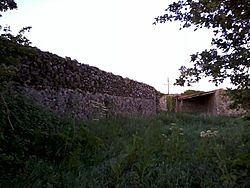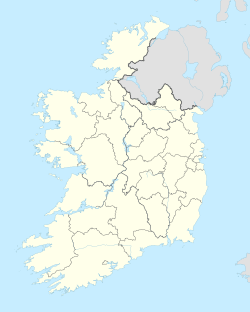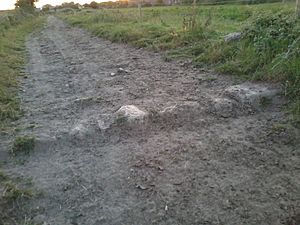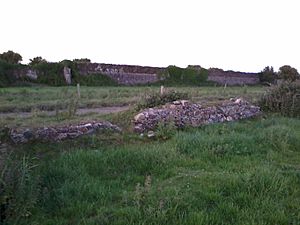Geneva Barracks facts for kids
Quick facts for kids Geneva Barracks |
|
|---|---|
| Beairic na Ginéive | |
| Passage East | |

Much of the remaining stone work can be seen
|
|
|
Location within Ireland
|
|
| Coordinates | 52°13′00″N 6°59′00″W / 52.21667°N 6.98333°W |
| Type | Barracks |
| Site history | |
| Built | 1783 |
| Built for | War Office |
| In use | 1783-1824 |
Geneva Barracks (Irish: Beairic na Ginéive) is a historic site in County Waterford, Ireland. It started in 1783 as a planned settlement called New Geneva. This settlement was meant for people from Geneva who had left their home country after a revolution.
The site was near Passage East. The Irish Parliament and the Crown (the British government at the time) approved the plan. However, the Genevans decided not to settle there. So, the colony was turned into a military barracks instead.
During the Irish Rebellion of 1798, the barracks became a prison. It held many captured rebels from the Society of United Irishmen. Many of these prisoners were sent away or forced to join the army. Today, only old ruined walls remain of New Geneva in a grassy field.
Contents
How Geneva Barracks Began
Ireland's New Plans
In 1782, the Irish government gained more control over its own affairs. This was granted by the British Parliament. This change gave the Irish Parliament in Dublin much more power.
Old rules that limited trade were removed. This led to many big plans for Ireland's economy and culture. One idea was to create a "colony" of skilled workers and thinkers. They hoped this would help trade grow.
Genevan Refugees Arrive
In 1782, a rebellion failed in Geneva. This caused many Genevan people to become refugees in Europe. These people were skilled artisans, meaning they were very good at crafts and trades. Their knowledge was highly valued.
Thousands of them were invited to settle in Ireland. A place in County Waterford was quickly chosen for them. It was named New Geneva to show where the first settlers came from.
A City Designed by Gandon
James Gandon, a famous architect, was asked to design the new town. His plan showed a nearly rectangular city. It would have a huge, shallow crescent shape, about 2,700 feet long. This crescent would look out over the Waterford Estuary.
Churches were planned for each end of the crescent. Streets and rows of houses would be behind them. A main square would have a central church. Other squares were planned for an academy and a market. A town hall and a prison or hospital were also part of the design. The city plan was similar to the French city of Richelieu. The barracks walls we see today are very different from this grand original plan. James Gandon's original drawing of the proposed city still exists.
From Colony to Military Base
The Colony Fails
A lot of money, £50,000, was set aside for the New Geneva project. But the colony quickly ran into problems. The Genevans wanted to have their own representatives in the Irish Parliament. They also wanted to govern themselves using their own Genevan laws.
This idea could not be agreed upon. So, the plan for the colony was stopped. The government then took over the site. They began to turn the settlement into a military base.
Barracks are Built
New barracks were built to house soldiers. These were companies of Irish militia. Militia were groups of citizens trained as soldiers. They were newly formed because a war had started between France and Great Britain in 1793.
The militia's job was to support the regular army. Regular forces were stationed across the water in County Wexford at Duncannon Fort. The militia also protected nearby Passage East in case of a French invasion.
1798 Rebellion: A Notorious Prison
Rebels are Captured
In May 1798, the United Irish rebellion broke out. It was most successful in County Wexford. For a time, County Waterford was also at risk. However, the rebels were defeated at New Ross on June 5. This stopped the Wexford rebels from spreading out. It also discouraged Waterford rebels from joining the fight.
After this, Geneva Barracks became a temporary holding center for rebels. By the summer of 1798, it always held at least 1,000 prisoners.
Harsh Conditions
The prison at Geneva Barracks quickly became known for its terrible conditions. Prisoners were treated very badly. P.M. Egan wrote about Geneva in his 1895 book Guide to Waterford. He shared a story told by Mary Muldoon:
"A fine young man was brought to the barracks in 1798. He was forced to join the soldiers. The poor fellow did not want to fight against his own family and friends. He asked the officer if there was any way to escape, other than the high wall around the barracks. The officer, perhaps joking, said if he could get over that wall, he would be free. So, the young man made a big jump and got onto the wall. But the officer was a bad man. He shot the poor boy on the wall. For many days after, the boy's mother, a widow, came to see the spot on the wall where his blood had been spilled. It was said to remain there for a long time."
What Happened to Prisoners
Most prisoners who were not sentenced to death were transported to Australia. This meant they were sent to live and work in a far-off colony. Others were impressed into the Royal Navy. This meant they were forced to join the navy.
However, some prisoners had a different fate. Representatives of the King of Prussia were allowed to choose the strongest men from among the prisoners. These men were sent to serve in the Prussian Army. This was partly payment for help given by Prussian soldiers in stopping the rebellion.
Thomas Cloney, a leader of the rebels, was held at Geneva Barracks. He was sentenced to death. But his sentence was later changed to exile by General Lord Cornwallis. Cloney later said that the scars from the handcuffs he wore at New Geneva were still visible decades later.
The Barracks Closes
The barracks was used less and less after the Napoleonic Wars ended. It finally closed in 1824. Today, only the outer walls and some buried remains show how large the original Genevan buildings were.




